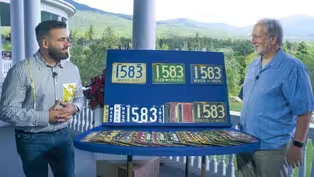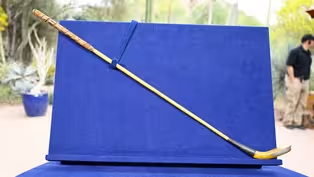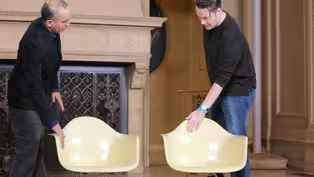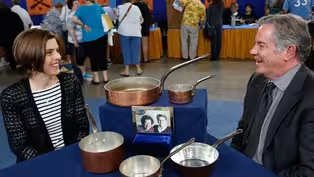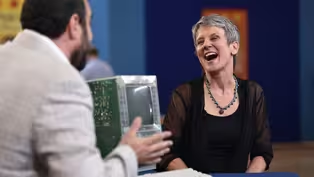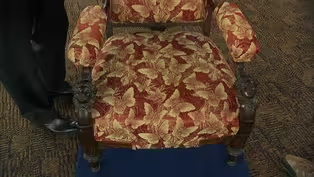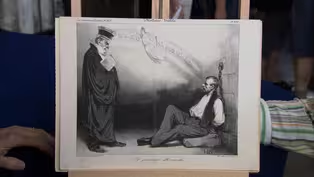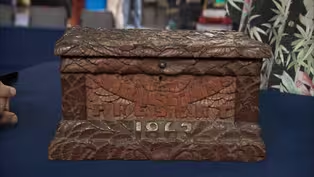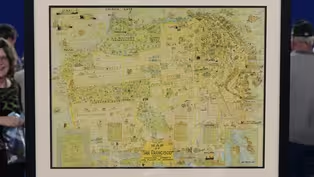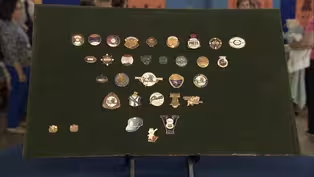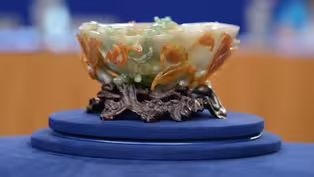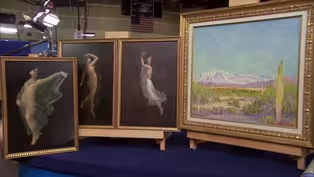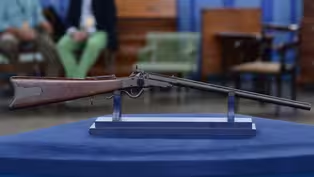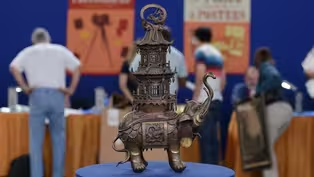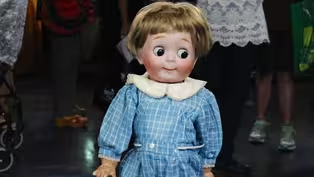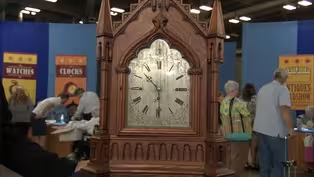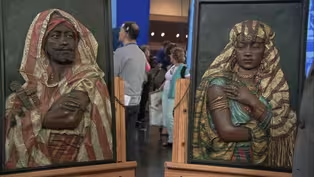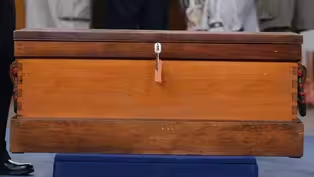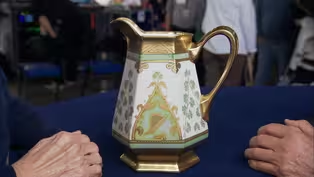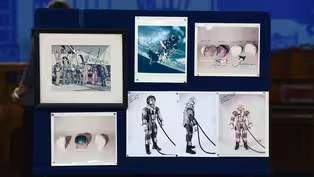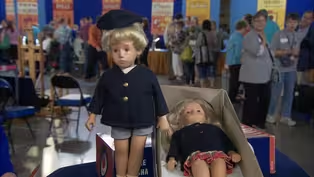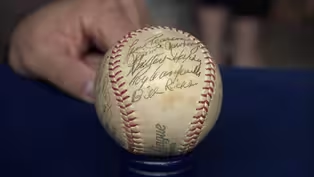
Junk in the Trunk 5, Hour 1
Season 19 Episode 32 | 53m 6sVideo has Closed Captions
See never-before-aired appraisals from this season’s eight-city tour.
Discover never-before-aired appraisals from this season’s eight-city tour, including a 1925 San Francisco pictorial map, NASA signed photos, and a Chinese jadeite peach-form bowl from around 1900. Which is the $40,000 to $60,000 treasure?
Problems playing video? | Closed Captioning Feedback
Problems playing video? | Closed Captioning Feedback
Funding for ANTIQUES ROADSHOW is provided by Ancestry and American Cruise Lines. Additional funding is provided by public television viewers.

Junk in the Trunk 5, Hour 1
Season 19 Episode 32 | 53m 6sVideo has Closed Captions
Discover never-before-aired appraisals from this season’s eight-city tour, including a 1925 San Francisco pictorial map, NASA signed photos, and a Chinese jadeite peach-form bowl from around 1900. Which is the $40,000 to $60,000 treasure?
Problems playing video? | Closed Captioning Feedback
How to Watch Antiques Roadshow
Antiques Roadshow is available to stream on pbs.org and the free PBS App, available on iPhone, Apple TV, Android TV, Android smartphones, Amazon Fire TV, Amazon Fire Tablet, Roku, Samsung Smart TV, and Vizio.
Buy Now
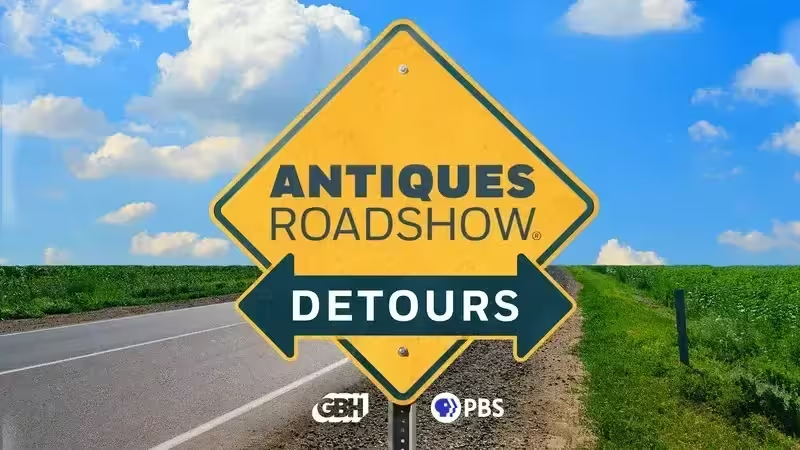
ANTIQUES ROADSHOW DETOURS
Ever wondered what happens to the treasures featured on America’s beloved ANTIQUES ROADSHOW after the cameras leave town? Host Adam Monahan tracks down the juicy afterlives of your favorite finds from PBS’s hit series.Providing Support for PBS.org
Learn Moreabout PBS online sponsorshipMore from This Collection
Video has Closed Captions
Discover all new appraisals from ROADSHOW’s Season 26 tour, like a find of up to $75,000! (52m 27s)
Video has Closed Captions
Discover never-before-seen surprises from our Season 24 tour. One is worth up to $100K! (52m 45s)
Video has Closed Captions
Discover never-before-seen appraisals from all Season 23 cities, like a $40K-$60K find! (52m 29s)
Video has Closed Captions
ROADSHOW’s bigger-than-ever 2014 season includes a second hour of junk! (53m 10s)
Video has Closed Captions
Discover more previously unseen appraisals from our eight-city tour. (53m 10s)
Providing Support for PBS.org
Learn Moreabout PBS online sponsorshipMARK WALBERG: So many impressive treasures turned up on our season 19 tour, we made two special "Junk in the Trunk" episodes of "Antiques Roadshow."
WOMAN: My father helped invent Apollo space helmets.
And did your father ever have any aspirations to be an astronaut himself?
Sure, didn't every kid?
WALBERG: There's more to come.
Stay tuned for the first hour of "Antiques Roadshow: Junk in the Trunk."
ALL: Roadshow!
(cheers and clapping) WALBERG: "Roadshow" traveled to Bismarck, North Dakota, for the first stop of our 2014 summer tour.
The wind was whipping down the plain on our visit to Fort Abraham Lincoln, while back at the civic center, the crowd's excitement was building.
I've been trying to get tickets for years.
Finally got tickets for the "Roadshow"!
WALBERG: Some thrift store bargains caught the eye of paintings expert Alasdair Nichol.
NICHOL: I understand you're a denizen of the thrift stores, is that right?
I am, I am.
And are these some of your finds?
They are.
I don't know much about them.
This one nearest you, I paid $14.
Fourteen dollars?
Yes, and these three, eight dollars each.
And do you know anything about this artist, or do you know who it's by?
No, I couldn't figure out the signature and I was hoping that maybe you guys could.
Right, well, I struggled a little bit with it to begin with, to be honest.
When I flipped it round and I saw that it was framed in Scottsdale, Arizona, that rather piqued my interest.
It's a part of the world that I actually spend a bit of time in, and I thought, "Well, maybe it's an Arizona artist."
So I did a little more delving, and I believe it's a work by Jessie Benton Evans, who was actually one of the best known Arizona artists of the early 20th century.
She moved there for her health around about, I think, 1912, 1913, early part of the 20th century.
So this is one of her works, a typical desert scene.
You paid $14 for this one?
Yes.
So this at auction should comfortably be $1,200 to $1,800.
Oh, wow.
So $1,200 to $1,800.
Awesome.
And these ones over here, very different paintings, but obviously they appeal to you too.
And do you know anything about these?
I don't, and they weren't signed.
Well, when you brought them out, I thought, "These are very reminiscent of an Italian artist "who lived in the 18th, early 19th century, Michelangelo Maestri."
And he did paintings of young muses, nymphets, in diaphanous gowns against a black background, so these are very typical.
Now, I don't think they are by him, but I think they're followers of, or they're in the circle of, and as such, they should be worth, I would think, probably $400 to $600 each.
So then $1,200 to $1,800 for these, $1,200 to $1,800 for this.
So you paid, what, $24 for that, $14 for that, so I would say keep going to the thrift stores.
Not bad.
WOMAN: I know that it's been in the family since about, I don't know, at least the 1800s, the late 1800s.
It belonged to my mother-in-law's aunt.
This was made by the Pickard Decorating Company, which is in Chicago, and let's take a look at the bottom and see the marks.
There's two marks here.
There's one in green which says "D&C France."
You might say, "Well, you say it was made in Chicago.
Why does it say France?"
The Pickard Company bought plain white china blanks from various factories around the world, especially from France and Germany and other countries, and then they employed highly skilled artists who would then hand-paint them.
The other mark, which says "Handpainted Pickard China," means that they hand-painted it in their factory by one of their artists.
So most hand-painted Pickard pieces like this have an artist's signature on it, so we always have to look for that.
Now, sometimes it's missing and sometimes it's hard to find, but in this case, we found it.
It's really hard to see.
Well, I didn't notice it.
Right here on the edge is a little bitty mark.
There were dozens and dozens of artists who worked there over the years, and this particular artist's name was Minnie Pickard.
She had the same last name as the company.
She married into the family.
Now, when we look at hand-painted Pickard like this, which usually dates sometime between around 1900 through the 1920s-- this would be right in the middle of that time period-- what we collectors like and what we look for is the pattern.
The more colorful, the more beautiful the pattern, the more unusual the pattern, and for some reason-- and we don't really know why-- Minnie Pickard is, like, the most desirable of all the many artists that worked there.
Oh, wow.
Now, she's not necessarily a better artist, but she's just more valuable.
But I was told years ago that the reason she's worth more money is because she has a lot of descendants and they all bid on her china when it comes up because they only want her pieces and they will pay a lot of money.
Now, I can't prove that that's true or not true, but she does bring a lot more.
A pitcher like this would normally bring, with lots of wonderful flowers on it, somewhere in the $250 to $500 range.
Right.
But her stuff brings a lot more, so a retail price for this would be somewhere between $1,000 to $1,500.
Oh, that's wonderful.
WOMAN: I got it from a French couple who had been dealers in Paris.
When the Nazis came into Paris, they packed up all their artwork and put it in storage and left, and they got a Nazi SS guy to come in and mark the crates, something that kept them from being opened during the war.
After the war, they went back and brought this stuff to the United States, and they were selling it.
Well, this is a very unusual Daumier print.
We see his lithographs a lot, and typically, they're printed on newsprint because they were published in "La Caricature" and other French journals of the time.
And he was really the first artist to really explore lithography, which was a new medium at the time.
This is on white paper.
This is what you want for lithographs from this period for collectors.
And then this is a very early print.
This is from 1834, when he'd just begun his series, and on top of that, it's a wonderful subject, because you have a political scene with a very scolding-looking judge looking down at the prisoner.
And his "Gens de Justice," which he did much later, are very desirable, and this has a judge in an early print.
It is very scarce.
At auction, the value would be $1,000 to $1,500.
Wow, and I probably paid $25 for it.
That's terrific.
Yeah, it is!
If it didn't have the center fold, the crease, it could be worth up to $2,000 at auction.
It's a wonderful example of his work.
Well, what I found here was a uniform.
It was buried in an attic in a house on a farm I bought.
There was a bunch of pictures and everything with it, and it all kind of ties in to a special mission in Norway in World War II.
Did you know the gentleman who had the farm?
Was this his uniform?
Yes, it is, and yeah, I did know him.
My brother farmed the land with him for a few years.
Well, it's an interesting uniform and it has a very interesting story to tell.
The gentleman was part of an operation where they dropped behind enemy lines into Norway.
Quite an operation, actually, the kind of thing that movies are made of.
They had quite a difficult time behind enemy lines.
These were a number of individuals that were chosen because they spoke Norwegian.
Norway was an area that we had originally planned to invade and didn't, but we certainly wanted to make it difficult for the Germans up there, and so these individuals were behind the lines, blowing up railway bridges, collecting intelligence from the locals and just generally making a nuisance of themselves.
But unlike a lot of special operations, they didn't go in, accomplish a mission, and get pulled out.
These guys stayed in Norway and received supplies through air drops.
They had quite a harrowing experience.
Most World War II uniforms honestly aren't worth a whole lot of money.
In most cases, a plain World War II uniform is $50 or $100 at best.
And in fact this one, with the moth damage that it has on it, which is quite extensive, would make it worth even less than that.
But the thing that makes this one particularly valuable is the insignia that's on it.
Right here on this shoulder, you see the Special Forces wing, the SF wing.
It's generally British-made and indicative of somebody who trained with the British.
Generally, the people who wore it had something to do with the OSS.
It's a wing that's heavily faked because it's a very valuable piece of World War II insignia.
This particular wing alone on its own, without any association to the individual, in 2014, a retail value for that would be between $1,800 and $2,000.
He's got American wings on the uniform, but then he also has British wings on that shoulder, as well.
Because you have a complete grouping, where we know for a fact that this is the original wing-- in fact, you can see in the photograph that he's wearing the wing in that very same uniform-- as a collector, you don't have to worry about the idea that it's a forgery.
You know absolutely that this is a genuine wing, you know the history of the individual and what he did.
A retail value for the entire lot today with the man's identification I would expect to be between $3,000 and $3,500.
Oh, wow.
Thank you.
That's... pretty good, yes.
ALL: Welcome to Santa Clara!
WALBERG: Our second trip brought us to beautiful Santa Clara, California, where collectors of all ages were eager to learn more about their treasures.
I want you to come up nice and close.
See how the image is made up of little teeny-tiny dots?
WALBERG: "Roadshow" is always on the lookout for items with regional history, and we found it with this fantastic map of the City by the Bay.
MAN: I bought it about five years ago.
It took me two years to get it because I made the mistake of saying, "I'll come back tomorrow," and it was gone, but I bugged the guy and finally two years later, I got it, so I've had it about five years.
And you bought it and you put it in this frame and you hang it and you really enjoy it, right?
Every day.
The map is by a man named Harrison Godwin, and it was done about 1925, and you can see the date up here: "San Francisco, 1925."
Now, Harrison Godwin was an illustrator who was born in 1899 in New Jersey, and he moved out to California in the 1920s.
And when he got here, he started doing maps like this, and these are called pictorial maps, and they were basically tourist maps, and they have a wonderful combination: their appeal to people who like maps, which I love maps and obviously you like maps, but they also have all these great illustrations.
And this was a very popular thing in the 1920s, and they did all sorts of regional maps in different cities around the United States, and Harrison Godwin did a number with a California theme.
He did California, he did one of the Panama Canal, he did a number of San Francisco, and this is his larger one of San Francisco.
They have all these little vignettes that have information.
Now, you've got one that you think is kind of interesting.
Can you tell me about that?
Right here there's a camel, and it kind of indicates that whole area was sand dunes for years and years.
Right, it's factual, it's got information, but it's humorous, and he's got lots of other wonderful illustrations.
I mean, down here, just to look at a few of them, here you have the area where they had the butcher shops and the slaughterhouses, and you can see, and they take that theme up here.
You have the city and county hospital with a doctor holding a cleaver.
You know, I mean, somewhat factual.
You also have other wonderful scenes, like here's the firehouse with a guy jumping out of a building, and then right next to it, you have the dog pound, and then if we move over here, we have a high school with a student getting spanked, and right above that, Ewing Field, which is a semi-pro field where they're having a fight rather than playing a ball game.
And this is filled with these little vignettes that have a historical basis but are a lot of fun.
Every day, I find something new.
Now, these are very popular and in fact, they make similar things today.
For a long time in the market, because they did a fair number of these, people dismissed them.
Now, how much did you pay for this?
About $140.
$140, and this was how long ago?
About five years ago.
Well, five to ten years ago, that's an appropriate price for them.
So the values have gone up and up and up.
What did you think this might be worth now?
$200, $250, maybe.
Right, okay, well, it's actually worth quite a bit more.
If this was in a retail shop, you'd probably see about $1,800 on it.
One recently went at auction for over $2,000.
Wow!
Well, you're my new best friend.
(both laughing) It's amazing.
WOMAN: This doll was my mother's eighth birthday present.
Her parents took her to Sanger Brothers, I think that's what it's called, department store in Dallas, Texas, and this was the doll she picked out.
Did she ever tell you why she picked this one out?
She didn't, actually.
I think it was because it had such a wonderful smile.
And after she was married, her husband would say to her, "I see why you picked out that doll.
She looks just like you."
Meaning that she had this little tummy, and he thought that was funny.
Okay, let's talk about it from head to toe.
It's a German bisque doll, it's a googly eye doll.
It's got a bisque head, exceptionally large, round eyes.
This wig is mohair.
Let's turn it around so you can see how it's marked on the back of the head.
It's completely marked "Made in Germany by John D. Kestner," and the mold number is a 221.
It's very unusual.
It's the largest sized googly they made.
It looks like what could be the original romper-type suit.
It's not, actually.
I bought that.
Okay.
It's on a papier-mâché toddler body.
The quality of the bisque is exceptional.
Is it a rare doll?
I mean, were these... how widespread were these?
It's rare in terms of size and being a googly.
Googly are probably some of the most sought-after German characters there are, and especially in this size.
They made them in sizes anywhere from ten inches, and this is 16-inch.
It's the largest size that they made.
Uh-huh.
And they were made, they were popular anywhere from 1900 to about 1920.
You said your mom got this doll in what year?
1913.
Which fits right in the range.
Yeah.
She's in very good condition.
What's there not to love about something unusual like this?
It's a very impish face.
Have you ever had it appraised?
I've not had it appraised.
She took it somewhere about 25 years ago, to an event, and I think they told her it was worth at least $700.
Wow, okay.
Well, I think I have some good news for you.
If you look at the size, the exceptional quality, and the very good condition it's in, I think in the auction market today, it would be between $12,000 and $13,000.
(laughing) Amazing.
I can't believe it!
You brought in this remarkable carved box.
Let's take a look at it first and then you can tell me what you know about it.
I mean, let's start with the lid here.
This is this great presentation, and who's the lady it's presented to?
It's presented to M.A.
Follet by her fiancé, who was a Civil War sailor on the Union ironclad the U.S.S.
New Ironsides.
And it was a Christmas present for 1863.
Yeah, and in fact it says right there on the front, "Christmas Present, 1863," but there's more, right?
We have written on the side, "Kindness," on one panel, "Heaven keep thee happy," and then... And this one.
"Think of me."
"Think of me."
And the best part is on the bottom, as far as I'm concerned.
And we have here the name of the carver, where he was from, what ship he was on, and when he finished the box.
And so his name was...?
S.D.
Ramsdell from the U.S.S.
New Ironsides, and he was from Pittston, Maine, and he actually carved it on the bottom of the box, which was amazing.
And what I find so fascinating is that he actually signed it, "Completed on December 24th, 1863."
So the next day, he gave the box to his sweetheart.
Now, like all good stories, there's more to this.
What happened to Ramsdell?
Well, Ramsdell, after he served his term of enlistment on the U.S.S.
New Ironsides, he apparently re-enlisted for the re-enlistment bonus, joined the 20th Maine Artillery, and he was a sergeant in the 20th Maine and was killed in the Battle of Petersburg in 1864, I think it was.
And so they never were able to get married.
It's a tragic story.
I know you want to know what it's worth.
I would think that in a good auction of folk art or Civil War material, you might expect to see this sell for between $4,000 and $6,000.
Oh, my gosh!
Maybe even a little bit more.
Well, that's amazing.
MAN: Well, the one on the left I actually got from a collector for about $200 at the time at a trade show.
He was blowing them out, and I bought that because I like the look of it.
And the second one actually has a very interesting story.
I was at an antique shop and this was sitting on the shelf, and they were charging $125 for it, but it had a crack, a couple small cracks in it, and I offered them $100 and they took it, so... Great!
Yeah.
These are two classic ukes.
This one is Leonardo Nunes.
Okay.
His father is attributed as being the father of the ukulele, the inventor of the ukulele, that's what he called himself, and Leonardo was his son, so of course his ukes aren't quite as valuable, but it's a classic handmade Hawaiian uke, flamed koa wood, very nice.
The other one is called the pineapple uke.
Of course, you can see the pineapple on the front, but the shape is like the pineapple.
This was made by Kamaka.
This would have been made in the late 1920s.
Oh, okay!
So both of these instruments probably date from the late '20s.
Okay.
It's a little hard to be exact on this.
The tuners have been replaced on this, and like you say, it's had some cracks.
But it has a beautiful rope binding on it, on the neck and the body.
Do you have any idea what the values of these are today?
I don't know.
I'm guessing maybe $1,000 for the...?
Right, well, they're close.
The uke with the pineapple, that's... On a retail level today, because of its condition, would be around $1,200.
Oh, okay!
And the Nunes, probably around $1,000.
Oh, good, so I did well, then.
You did very well.
Okay, great!
WOMAN: This is a piece that's been in my family as long as I can remember, and I believe it was originally purchased by my grandfather.
APPRAISER: Do you know about what date your grandfather acquired it?
If I had to guess, it would probably be sometime in the early 1900s.
It looks like a piece that would have been acquired somewhere around 1890 to 1920, which was about when it was made.
It's a piece of jadeite that is in peach form.
It was probably meant as a birthday present for a very wealthy person.
Made in China in the latter part of the Qing Dynasty from beautiful multicolored jadeite, which was a highly revered stone in China, that started to be carved in about the 18th century.
This was really a cabinet piece, a presentation piece.
Do you know what the wood is, what kind of wood that is?
It's a rosewood.
A rosewood?
Right, but beautifully carved and very complimentary of the example.
Do you have any idea of what you think it might be worth?
I have no idea.
My husband and I have been sort of having a disagreement over what it's worth, because I'd heard that jade had really plummeted in value as a result of the Chinese being able to machine-carve jade, and so I didn't think it was worth very much.
Well, that is true for a lot of jadeite, because there was a big boom in carving jadeite in the 1980s, and a lot of pieces came on the market and the prices became so astronomical, and then suddenly dropped because people knew that they were machine-carved.
But this is a tour de force, this is an exception to the rule here.
Oh, okay.
Now, at auction, currently, this piece would carry a pre-sale estimate of $40,000 to $60,000.
You're kidding.
Really?
It's a marvelous example of its type.
It's really an exceptional piece, beautiful color...
It is beautiful, I love it.
...tour de force carving.
Thank you very much for bringing it in.
Thank you!
WALBERG: In Birmingham, Alabama, I found a couple who had a great idea for carrying their antiques.
You're actually using your items as transport, is that right?
Yes, sir.
What have you got, you got some prints and paintings here, and then one of the most valuable things you can have in line is an antique chair, which if the line's too long, you can obviously sit in it and relax.
If she'll let me.
But she won't let you.
No, sir.
All right, well, good luck to you.
I hope everything gets there safely.
Yes, sir!
WALBERG: And a family heirloom came to us with an unusual story of collaboration with a famous American woodcarver.
This blanket chest was made by my great-great-uncle, John Lawrence, for his wife, Mary Frances.
Now, they were married about 1859, and we understand through the family that John Lawrence, who really didn't have a workshop, he was a ship's captain, he made this blanket chest at the workshop of his very good friend in Kittery Point, Maine, John Haley Bellamy.
We understand that since Uncle John was a ship's captain, he probably made the rope handles, but the chest itself I think probably called for more than he himself could do.
John Haley Bellamy was known as the carver of eagles.
He made these really unique American eagles...
Incredible works.
...and ship's figureheads.
And you got this by descent in...?
I got this, I inherited it.
Mary Frances and Captain John didn't have any children.
Captain John died in 1907, Mary Frances died in 1915, and my great-uncle Elry, who had taken care of them, came into the furniture of the house, and this was one of the pieces, and he gave it to me because Captain John had sailed on the seas and I was the only member of the family that actually went into the Navy.
Okay, I think it's neat for a variety of reasons.
One is that based on construction of the blanket chest-- the butt hinges, the way the lock is installed, the other fasteners-- it tells me that it is probably made around the time of the third quarter of the 19th century, so it corroborates the marriage dates that you mentioned earlier.
The Bellamy association is significant because he's known, as you mentioned, for his fantastic eagle carvings, some of which have brought six figures.
Really expensive objects and very popular in the folk art world, in the world of Americana.
I think this is interesting because I suspect that what you shared about who made this might be backwards.
The beckets that are on this piece are these wonderfully painted red and green rope handles.
Uh-huh.
And that's something that I would expect John Lawrence to have done, being a ship captain.
And he may have made the box, the entire carcass, back at Bellamy's shop, but in doing some research, I noticed that the carving of the cleats that actually holds the beckets to the sides of the case are very, very representative of Bellamy's work.
I've seen some architectural elements that look similar to these, and the way that the sides of the carving underneath here, the way it almost looks like wing tips in here...
Yes?
...reminds me of the wing tips that you see on the Bellamy eagles.
So I think Lawrence might have made the box, but Bellamy made the cleats that hold the beckets to the box.
It's a really great object.
If it were just an unadorned American pine box from New England, you'd be looking at something that might be $300.
Uh-huh.
If the beckets were to come along on their own, not attached to the box, they're probably about $800, because they're so vivid and vibrant and beautifully made.
People do collect beckets.
The combination of this being a family piece, having the excellent red and green beckets, the fact that the cleats were carved by Bellamy on this box in his shop, I would say that if this were to be an auction estimate here, you're looking at $1,500 to $2,500.
Oh, boy.
And if it had an older surface, it could be even higher.
Mm-hmm.
I brought this gun that was in my great-great- grandmother's house at the end of the Civil War.
That's really all I know about it.
She lived, I believe, in Mississippi, and the story is it was left there by a Union soldier.
Okay, and what kind of gun is it?
Well, from the name on it, I've discovered it's a Marbury carbine.
We're close, it's a Maynard carbine.
Maynard!
And on front we have "Maynard, Washington, D.C." Right.
Maynard was an inventor, an amazing inventor.
He had so many patents for firearms and firearms improvements.
This is one that he's best known for.
You remember the old cap guns that had the primer tape that rolled up, that popped?
Yeah.
Maynard helped develop that.
If we open this door, we actually see on the inside the little wheel.
You put the roll of caps in there.
As you cock the hammer back, it'll rotate those up, which works great if two things don't happen: if the wheel doesn't break, like this one has, or if they get wet.
Either happens, you're out of luck.
So, it was a cool thing on paper, but once you got in the field, it didn't hold true.
They tried it on several guns.
The government actually liked the idea so much that they paid him quite a substantial sum to use his patent.
And one thing that we have on the inside of the door is the serial number of 2406, which is important.
The first few hundred went to the U.S. government.
From there, a lot of the guns went South.
Okay.
They were sold right at that gap where everybody knew war was coming, but they were still selling stuff to the South.
Okay.
And some of them went straight from Maynard and some of them were sold through a retailer in New York.
Unfortunately, we don't have those exact serial numbers, so we can say that this one is in the range that could be a Southern gun.
Okay.
Most of these guns were made, though, in 1858, 1859.
They're really cool guns because they're .50 caliber, but they used them almost like a sharp-shooter's gun, and that's what this is on the back.
We actually have the long-range sight.
Right.
The front one is a steady sight for 200 yards, and this one is adjustable for long range.
It's nice that this is on.
You can imagine it doesn't take a lot for that thing to pop off.
The gun is very crusty.
Yeah!
(laughing) But it's crusty beautiful!
Okay.
When you look at a gun like that, you know it was there, you know it saw service, and to a collector, we get that feeling, "When I'm holding this, I'm holding history."
Oh, yeah.
Which is a wonderful thing.
Have you ever had the gun appraised?
No, no, it hung in my parent's home over the mantel for 30 years probably, and then has been in a closet.
Any gut feeling as to what it would be worth?
I did a little bit of research, and it said like $2,000, $3,000, something like that.
That's...
I mean, that's it, that's all I know.
Right.
Well, when you look at it, it does have that crusty appearance.
It's a gun that we'd be looking for an insurance value, because I assume coming out of the family, you wouldn't be interested in selling it.
Absolutely not.
In today's world, this is a gun that I would insure for about $4,000.
Okay, that's great!
Did you ever open the little box on the back?
No, I tried and I couldn't open it.
Well, this is called a patch box, and what's cool about this one, we pop that open, it has a spare nipple, and that's what the percussion cap or the tape primer would roll up onto to cause the firing.
This one used one that's different than anything else.
Okay.
It's got a spare in there, and that little spare is worth about $250.
And it's in there?
It's in there.
That's cool.
A little bonus.
That's cool.
We found this ball at my uncle's house after he passed away.
He got the ball in 1951 when he was 22 years old at an exhibition game in Aniston, Alabama, the Birmingham Barons versus the Roy Campanella All Stars.
The Roy Campanella All Stars, and this is 1951, so Roy Campanella's already in the big leagues with the Brooklyn Dodgers, an MVP, one of the best players of his time, of his generation, certainly.
What's great about this ball is 1951, after the season ended, Roy Campanella assembled a number of his friends in the big leagues, also African Americans, who had played in the Negro Leagues.
Okay.
So, it's basically an All Star ball of these great former Negro League players who were now playing in the Big Leagues.
So we have, of course, Roy Campanella on this ball.
Roy Campanella famously and unfortunately got into a car accident in the later '50s and lost his ability to sign things, so there isn't a lot of his signatures out there, obviously very little post his accident.
So, that's very cool that that's here.
That is cool!
But there's some other great signatures on here, too.
Most importantly, we'll talk about the Hall of Famers.
Roy Campanella of course would be in the Hall of Fame later, as would Monte Irvin, right here.
And probably most famously, Willie Mays.
Twice!
And that is very interesting that it's signed twice, and that's not uncommon.
You know, as these baseballs were passed around the clubhouse, guys would sign it, some would come back to them and sign it again.
It doesn't add any extra value to it, it's just, you can't go wrong with two Willie Mays signatures.
No, you can't!
It's great.
Willie Mays is a rookie in 1951.
He's only a few years out of being a Birmingham Black Baron himself.
So, here we have a baseball filled with this wonderful and rich Negro League history, and it's from 1951, so it's a time when these Negro Leagues are transitioning into the major leagues, making such a huge difference.
And the Negro League team itself, the Birmingham Black Barons, are still playing at the time, so it's a fascinating ball.
It's in beautiful condition, too.
That's what I was wondering.
Yeah, it's in beautiful condition, immaculate, signatures are bold, early signatures.
It's got everything going for it.
If I were to insure it, I would insure it for nothing less than $4,000.
Oh, wonderful, wonderful.
That's great!
MAN: My wife and I visited an estate sale earlier in the year, and saw the chair, and loved it, had to take it home with us.
APPRAISER: This chair dates from the third quarter of the 19th century.
So roughly 1875 to 1880.
It's a time in American history that's marked by great design, great money.
One of the primary makers is Herter Brothers, which was an interior decorator and a cabinetmaker.
When we say cabinetmaker, we mean they're producing one-of-a-kind-type furniture-- not multiple examples of it.
And this is similar to that, the type of work that's produced.
It's what we refer to as the Aesthetic Movement.
It's light, it's meant to be not just a chair, but to have a function of art.
So when you walked in, I thought, "Is that the chair?"
And I knew immediately what it was, and that's confirmed... by the book published from Herter Brothers.
Okay.
In 1994.
Wow.
And when we open it up...
There it is.
We find the exact chair.
Right.
At the time of publication, there were ten copies of this chair known.
Wow.
Mostly in pairs.
They were made for parlors and for bedrooms.
This particular chair is in the Metropolitan Museum of Art.
(chuckling): Wow.
There's also examples in the Philadelphia Museum of Art.
Wow.
We're trying to date these chairs.
So we can pinpoint them down to 1875 to 1880.
There's a numbering system that's found on nearly every example on the back seat rail.
Okay.
I'd like to see if that was present.
Would you mind if we... Sure!
...took it apart?
Sure!
I can see the silhouette of that four-digit number.
And I can't quite determine exactly what it is, but it appears that it starts with a four, which would be consistent with the other chairs, which begin at 4400 and go to 4800.
Herter Brothers created furniture for the richest, most sophisticated people around the country.
This chair would have sat in a very prominent home.
Wow.
And it would be the pinnacle of design in the late 19th century.
How much did you pay for it?
$150.
Yeah.
And that was marked down.
I think this was the third day, so I think maybe the original price was $300.
It's not without issues-- it is original, it's authentic, it could benefit from some restoration.
As it sits, $10,000 at auction.
Wow... wow.
Great!
I could see the right collector in a retail setting paying as much as $25,000 if the chair were put together appropriately.
WALBERG: Austin, Texas, was "Roadshow's" fourth stop on tour.
While I made a friend taping a segment on Mexican saddles...
I'm gonna get up there, we're gonna ride, and we're gonna do it for TV, so you gotta make me look like a cowboy.
Can you do that?
H'ya!
Space cowboys were on our radar back at the convention center.
I brought a collection of NASA memorabilia my father left for us.
He helped invent the Apollo space helmet, so he worked at NASA's Houston center in the '60s.
And what was his capacity there?
He was in the human engineering, biomedical, bioresearch area.
So he did quite a bit.
I assume so, yes.
He was one of the premier aeronautical engineers at the time, Dr. Robert Jones.
Yes.
What else can you tell me about the helmet?
The helmet itself was a contest, and so he and another gentleman went in together and came up with this design, and he modeled it after Buck Rogers, so... That was his inspiration?
Yes, it was.
Was Buck Rogers.
He felt as though you should be able to see all the way around.
He wanted it to be a bubble.
Yeah, the bubble helmet or the pressure bubble, we've heard it called also.
And in the photos here, those are him modeling it?
Yes, it is, yes, the suit, and those were all the tests for the functionality of the suit itself.
And what other experiences can you remember that he would tell you about the times there?
They were a wonderful... it was wonderful years, he was very excited.
There was always wonderful things going on.
He did bring home a couple of astronauts for us to meet, so we got to meet several of the astronauts.
It was all very exciting times.
There was just this great camaraderie of gentlemen working towards a goal.
And who was your favorite to meet?
The one I remember most is Wally Schirra.
What was it about Wally?
He was nice, but you know, I was probably four, five years old, and he was a big, tall guy, but he was a very nice man.
And did your father ever have any aspirations to be an astronaut himself?
Sure, didn't every kid?
So yes, that's how he wound up at NASA, is he actually went to try to be an astronaut.
And then they recruited him for some other...?
Yes.
Well, we start off with the photo of the Mercury, the original seven...
Correct.
Mercury Seven here.
Signed by all seven here.
Well, this photo, we would put an estimate at auction between $5,000 and $6,000.
Oh, my.
And the photo here of Ed White, what did he tell you about that?
Well, he told me that that would be important because that was NASA's first walk in space, so that was the first out-of-the-vehicle experience.
And at auction, we'd put a price of between $1,000 and $1,500.
Wow.
Now lastly, we have the interesting photos here of showing the development of the helmet.
Some of the early prototypes here, wonderful photos.
We have a group of five photos here.
At auction, we would estimate these between $1,000 and $2,000.
Wow.
Thank you, that's exciting.
So we have an estimate, at auction, of between $7,000 and $9,500.
Okay, wow, that's quite a bit.
For insurance purposes, we would put the value at $10,000.
Okay.
Thank you.
Wow.
Now, what can you tell me about the helmet itself?
It's unbreakable, I could tell you that.
We tried desperately as children to break it.
And where is the helmet?
It is in the family.
For your information, for insurance purposes, we would put a value on that of $25,000 to $35,000.
Okay, thank you very much.
For the helmet itself.
Maybe we shouldn't have taken it to show and tell all those years.
WOMAN: It was given to my husband like 40 years ago, just by a friend.
They had been out partying.
And I don't know what it is.
I don't know if it has a function.
I'm not sure what it's even made out of.
I thought it was from India, but now I don't know.
I always like to start with the basics.
Okay.
Which is, it's an elephant.
Right.
And it's not just an ordinary elephant, it's an elephant with a structure on its back.
It has a dragon, and this is a saddle cloth, and then there's this other blanket that goes over the top of that, and these pendant tassels, all of which have little loops here that suspended other tassels.
And as we flip this around, one of the things that we notice is the surface.
It has this chocolate brown color.
So in terms of where did it come from, I think it's safe to say it's Asian.
You knew it was... you thought India.
We were in the right line.
You were in the right place, so we're trying to narrow this down.
India doesn't really have a tradition of using dragons as part of the decoration.
China and Japan do.
One of the features that is associated with Chinese and Japanese bronze is a form called a censer, and a censer is meant to hold incense.
And the smoke from the incense rises up and comes out of the apertures.
My daughter-in-law was right; she said it was an incense burner.
But not just an ordinary incense burner, this a very decorative incense burner.
You get, in both China and Japan, the use of elephants holding these pagoda structures on the back that we use as censers.
Okay.
The difference is in the details, and one of those details is the color of the patina.
This chocolate brown color is specifically associated with Japanese bronze making.
The kind of brush stroke wash of the gilding is also associated with late Meiji bronze making, and mid to late Meiji, so we're talking about somewhere in the 1880s, 1890s, maybe as late as 1900.
Now, the other clue that substantiates my hunch that this is Japanese, not Chinese, is this is called a minogame.
Minogame, which is this turtle, this sea turtle that rises from the depths of the water very infrequently and lives to be a very old, old age.
And it has all this kind of seaweed, water grasses, the moss, algae that grows onto the shell, and that's exactly what we have here.
So this is a Japanese version of a Chinese 18th century bronze censer.
So you get the Chinese versions that look very similar.
Right...
In fact, so similar that they're difficult to tell apart.
Never would have thought.
Pretty decent shape, even considering the missing elements.
It's big, it's splashy, it attracts attention.
Well, I think that conservatively, it's in the $2,000 to $4,000 range at auction, could easily do a lot more.
The Chinese version of this is worth about $20,000 to $30,000.
Hm!
So, we have some Matt Groening artwork here.
What can you tell me about this and how you got it?
WOMAN: Well, in the mid-'80s, I lived in Los Angeles and I worked with Matt Groening and his girlfriend Deborah Caplan, marketing his first cartoon strip called "Life in Hell."
APPRAISER: Wow.
WOMAN: And we published books and had merchandise that we marketed.
APPRAISER: Well, this is very early on, obviously.
This is pre-"The Simpsons" that we all were introduced to on "The Tracey Ullman Show," that then went on for decades and decades.
"The Simpsons" still continues today, but it's, I think, one of the most famous American cartoon characters at this point, the entire Simpsons family.
And it's wonderful that you were kind of a part of the very beginning of his story.
WOMAN: It was very exciting.
Well, I guess the main piece I want to talk about here is the "Life in Hell."
This is the first issue of his self-created comic book.
WOMAN: I think it is.
I moved to Texas after I had worked with him, so years later, I was looking through my things and I found that, and I looked at the date and it said "1977, number one."
I think that is his original first issue.
WOOLLEY: And he signed it for you here, which is really cool.
WOMAN: And he signed it for me.
WOOLLEY: And then the other pieces we have are actually original pieces of artwork that he also signed and dated.
WOMAN: When I had my baby, that was a card that Deborah brought to my baby shower that Matt had done especially for me.
WOOLLEY: Very cool.
Well, they're obviously very special to you because you had a personal relationship with the family.
So, looking at the market for them and what they might sell for today, we have to kind of take apart all of the personal connection.
And if they were on the market, it's kind of a developing market.
Obviously he's hugely popular, but the show's still running, so things continue to go up in price.
Right now, sketches of his routinely sell in the $300 to $500 range at auction.
However, these are particularly early, so the original artworks that you have here on either side I would say are more in the $600 to $800 range, if not more, at auction, and for insurance, I wouldn't put anything less than at least $1,000 to $1,500 apiece on them.
For the original comic, it's difficult because there are very few that have come up for sale.
WOMAN: I haven't seen them at all.
WOOLLEY: They're rare, he didn't make that many, he was making them himself.
They're Xeroxed copies, but he did sign it.
Some of them that we found that are later issues sell in the $100 range, so this one being the first, it's really difficult to say.
I think being conservative, we'd say at least $200 to $300 at auction, but who knows what would happen on the day, because so few have ever come up and he signed it, which is really great.
Right, thank you.
Thank you.
I got this in an estate sale about ten years ago here in Austin.
Really, really liked the way it looked.
I thought it was very unusual.
I took it to a clock maker and they told me it had a triple fusee movement and had a verge clutch, which I'm not really sure what that all means, but anyway, that's what I know.
And what did you pay for it at the auction ten years ago?
It was an estate sale, and I got it for $600.
They wanted $800 for it and I kind of talked them down a little bit.
Oh, that's great, I mean, what an attractive clock it is.
It's massive, very impressive.
It's a Gothic style, probably would have been displayed in a public office, like a bank.
It's just sort of oversized and it has this wonderful dial.
It's an English bracket clock, is what we call it.
It was made in the last quarter of the 19th century.
Okay.
It's a three train movement, meaning it's quarter striking.
It strikes every 15 minutes.
(bell chimes) And there it goes.
And there it goes right there, yeah, it's talking to me now.
It also plays a Westminster chime, one that's really nice to listen to.
And that's what the three winding arbors are all about.
One runs the time, one powers the strike, which is the hour on the hour, and the other one powers the Westminster chime, and it also has this "chime silent" indicator up here, so you can shut it off if you had company over and it was too loud, because it plays on these magnificent gongs.
This is a retailer down here, this W. Hislop, London, and Tunbridge Wells.
He was a retailer of the clock, not the maker.
We really don't know who the maker was.
That's why I never found any information.
It's really not signed.
The case is all oak.
It just has a wonderful presence.
Do you have any idea of the value at all?
I have no idea.
I was hoping that it would be worth more than what I paid for it, obviously, but you know... Well, it is.
It's a clock that in a retail situation would sell in the $2,000 to $2,500 range today.
Wow, fantastic.
You brought us this great sports pin collection from your grandfather.
Who was your grandfather and how'd he get these?
Sid Feder.
He was one of the first sports writers for the Associated Press, and I guess he collected them as he attended various championships: the World Series, NFL championships and the like.
That's great.
What kind of a life did he lead in New York as a writer?
I guess they would be considered in the celebrity sphere, him and my grandmother.
They had a lot of associations in the sports world, writing, and the literary world.
Apparently he knew Frank Sinatra pretty well.
Really?
They hung out?
Yeah, there's a story that when he was in the hospital, Frank Sinatra ended up paying his hospital bills.
Wow, so he led quite the life in the '30s, '40s, and '50s.
Apparently, as my grandmother would relate, they had quite the life, yes.
And this is his legacy to you.
And this is his legacy to me.
Well, you know, the history of sports press pins really came about in the early 1900s.
Now, your grandfather, it appears from these, started in 1936 here, and we go to 1953 here.
This collection covers World Series, NFL championships, and All Star games from 1936 to 1953.
He was able to be a sports writer really in probably one of the sweetest times to be a sports writer in New York.
You had the Yankees, it seemed like they were in virtually every World Series.
The Giants weren't far behind, and neither were the Brooklyn Dodgers.
He also made it to some NFL championships with the Giants, as well.
Now, when we look at press pins, we value them by the age, the condition, the actual way that they look, how ornate that they are, and the team that the represent.
Now, you have a number of valuable pins here.
One of my favorites and one of the most valuable is this, which is the 1936 World Series, Joe DiMaggio's rookie year.
That pin alone is probably about $1,000.
This pin, which is from 1938, and you see how that pops with the gold?
That's really rare, too, from 1938.
It's almost like it was never used.
That pin is about $1,300.
These three pins you'll notice are not nearly as ornate or colorful as the rest.
They're made by Dieges and Clust, and they were japanned, as you see.
They're enameled, these pins, but not these, and that's because they're from World War II.
Oh, that makes sense.
Materials were scarce.
Now, there's one other very interesting pin here, 1946 Brooklyn Dodgers.
You know why that's interesting?
They call it a phantom pin.
They never played in the World Series that year.
Really?
They tied with the Cardinals, they lost the playoffs with the Cardinals, and the Cardinals ended up in the World Series.
Very cool, you'd never expect that.
And has anyone ever offered your family money for these?
Apparently, in the early '70s, somebody made an offer to my mother for the collection.
And how much was that?
Roughly $10,000 from what I've heard.
Well, you know, that was a very fair offer in the '70s.
Looking at these today, if you were going to add them up individually, it would be an auction value of about $15,000 individually.
However, I'd place a premium on these for two reasons.
One, they're this collection from '36 to '53, which represents the Yankees specifically, and they have the provenance of your grandfather.
So if I were insuring these, I'd insure these for $20,000.
That's good to know!
That's good to know, because they're not going anywhere.
WALBERG: We hope you enjoyed this first hour WALBERG: And now, it's time for the Roadshow Feedback Booth.
I bought these two books at a Claus for a Cause thrift store in Bismarck, North Dakota, paid $1.99 each, and what I'm gonna make on them, I'm gonna get a haircut.
Remember, the camera adds about 40 pounds, all up here.
Thanks!
I'd like to thank "Antiques Roadshow" for having us, and my dad for instilling a love of garbage picking in me.
And we brought a whole... a complete set of cups from Occupied Japan, and they're worth five dollars, but we got to see the camera go up and down, right?
And we had a lot of fun.
My planter's not worth quite as much as I thought it was, but for a 25 cent investment, I'll take $2,500 any day.
And the appraiser looked at the box and was kind of excited, but then when he actually saw the toy, he thought he liked the box better than the toy.
We've spent our first anniversary at the "Antiques Roadshow."
Roadshow.
(laughs) And my painting was worth $1,000!
And your buckle?
And my buckle's worth $20.
(laughs) And thank you.
Thank you.
We've had a great time!
We had fun.
I'm Mark Walberg.
Thanks for watching.
See you next time on "Antiques Roadshow."
Hi, you guys!
Now, you didn't bring a brand new TV to Roadshow... you did?
Captioned by Media Access Group at WGBH access.wgbh.org
Appraisal: Herter Brothers Arm Chair, ca. 1865
Video has Closed Captions
Clip: S19 Ep32 | 2m 46s | Appraisal: Herter Brothers Arm Chair, ca. 1865, from Palm Springs Hour 3. (2m 46s)
Appraisal: 1834 Daumier Lithograph Print
Video has Closed Captions
Clip: S19 Ep32 | 1m 33s | Appraisal: 1834 Daumier Lithograph Print, from Junk in the Trunk 5, Hour 1. (1m 33s)
Appraisal: 1863 S.D. Ramsdell Carved Wooden Box
Video has Closed Captions
Clip: S19 Ep32 | 2m 8s | Appraisal: 1863 S.D. Ramsdell Carved Wooden Box, from Junk in the Trunk 5, Hour 1. (2m 8s)
Appraisal: 1925 San Francisco Pictorial Map
Video has Closed Captions
Clip: S19 Ep32 | 2m 58s | Appraisal: 1925 San Francisco Pictorial Map, from Junk in the Trunk 5, Hour 1. (2m 58s)
Appraisal: 20th-Century Professional Sports Pins
Video has Closed Captions
Clip: S19 Ep32 | 3m 26s | Appraisal: 20th-Century Professional Sports Pins, from Junk in the Trunk 5, Hour 1. (3m 26s)
Appraisal: Chinese Jadite Peach-Form Bowl, ca. 1900
Video has Closed Captions
Clip: S19 Ep32 | 2m 28s | Appraisal: Chinese Jadite Peach-Form Bowl, ca. 1900, from Junk in the Trunk 5, Hour 1. (2m 28s)
Appraisal: Collection of Paintings
Video has Closed Captions
Clip: S19 Ep32 | 2m | Appraisal: Collection of Paintings, from Junk in the Trunk 5, Hour 1. (2m)
Appraisal: First Model Maynard Carbine, ca. 1858
Video has Closed Captions
Clip: S19 Ep32 | 4m 13s | Appraisal: First Model Maynard Carbine, ca. 1858, from Junk in the Trunk 5, Hour 1. (4m 13s)
Appraisal: Japanese Bronze Censer, ca. 1900
Video has Closed Captions
Clip: S19 Ep32 | 3m 37s | Appraisal: Japanese Bronze Censer, ca. 1900, from Junk in the Trunk 5, Hour 1. (3m 37s)
Appraisal: J.D. Kestner Googly Eyed Doll
Video has Closed Captions
Clip: S19 Ep32 | 2m 35s | Appraisal: J.D. Kestner Googly Eyed Doll, from Junk in the Trunk 5, Hour 1. (2m 35s)
Appraisal: Late 19th-Century English Bracket Clock
Video has Closed Captions
Clip: S19 Ep32 | 1m 58s | Appraisal: Late 19th-Century English Bracket Clock, from Junk in the Trunk 5, Hour 1. (1m 58s)
Appraisal: Louis Hottot Relief Plaques, ca. 1870
Video has Closed Captions
Clip: S19 Ep32 | 30s | Appraisal: Louis Hottot Relief Plaques, ca. 1870, from Junk in the Trunk 5, Hour 1. (30s)
Appraisal: Maine Pine Blanket Chest, ca. 1865
Video has Closed Captions
Clip: S19 Ep32 | 3m 48s | Appraisal: Maine Pine Blanket Chest, ca. 1865, from Junk in the Trunk 5, Hour 1. (3m 48s)
Appraisal: Minnie Pickard Pitcher
Video has Closed Captions
Clip: S19 Ep32 | 2m 23s | Appraisal: Minnie Pickard Pitcher, from Junk in the Trunk 5, Hour 1. (2m 23s)
Appraisal: NASA Signed Photos, ca. 1965
Video has Closed Captions
Clip: S19 Ep32 | 3m 33s | Appraisal: NASA Signed Photos, ca. 1965, from Junk in the Trunk 5, Hour 1. (3m 33s)
Appraisal: No-Philtrum Sasha Morgenthaler Dolls by Götz
Video has Closed Captions
Clip: S19 Ep32 | 30s | Appraisal: No-Philtrum Sasha Morgenthaler Dolls by Götz, from Junk in the Trunk 5, Hour 1. (30s)
Appraisal: Roy Campanella-Signed Baseball
Video has Closed Captions
Clip: S19 Ep32 | 2m 30s | Appraisal: Roy Campanella-Signed Baseball, from Junk in the Trunk 5, Hour 1. (2m 30s)
Appraisal: World War II Uniform with Special Forces Wing
Video has Closed Captions
Clip: S19 Ep32 | 3m 6s | Appraisal: World War II Uniform with Special Forces Wing, from Junk in the Trunk 5, Hour 1 (3m 6s)
Providing Support for PBS.org
Learn Moreabout PBS online sponsorship
- Home and How To

Hit the road in a classic car for a tour through Great Britain with two antiques experts.













Support for PBS provided by:
Funding for ANTIQUES ROADSHOW is provided by Ancestry and American Cruise Lines. Additional funding is provided by public television viewers.


